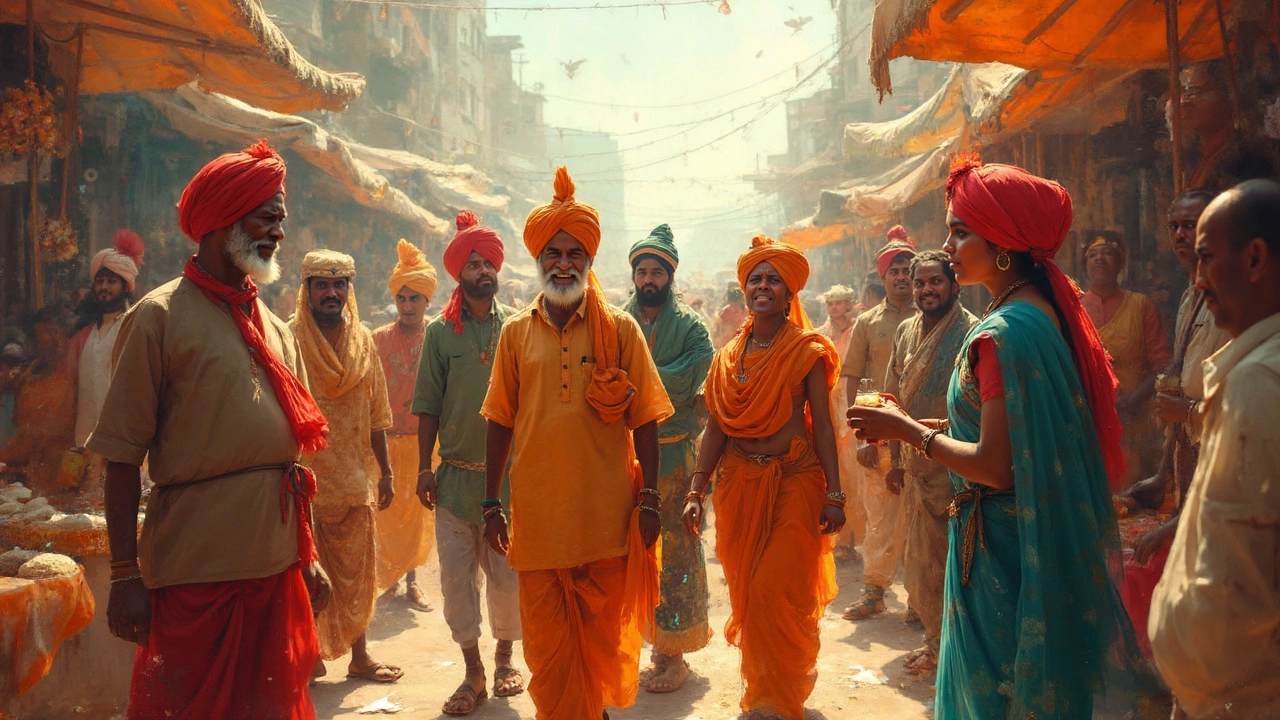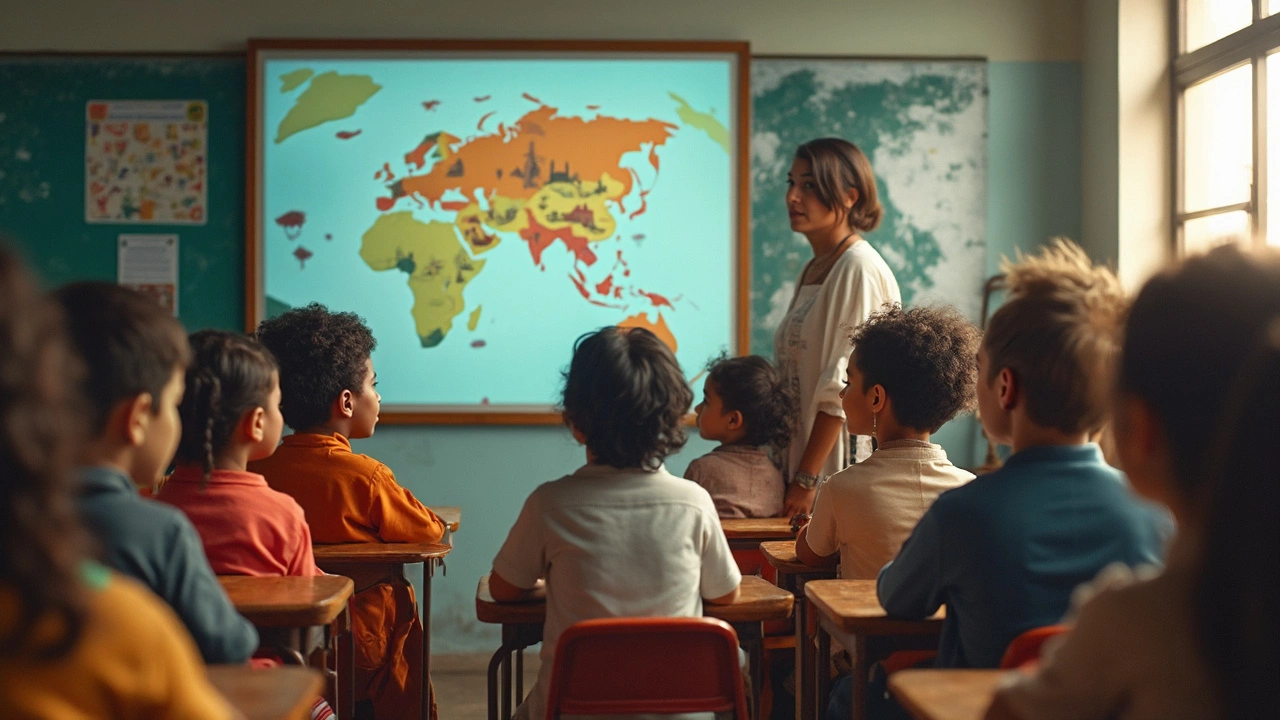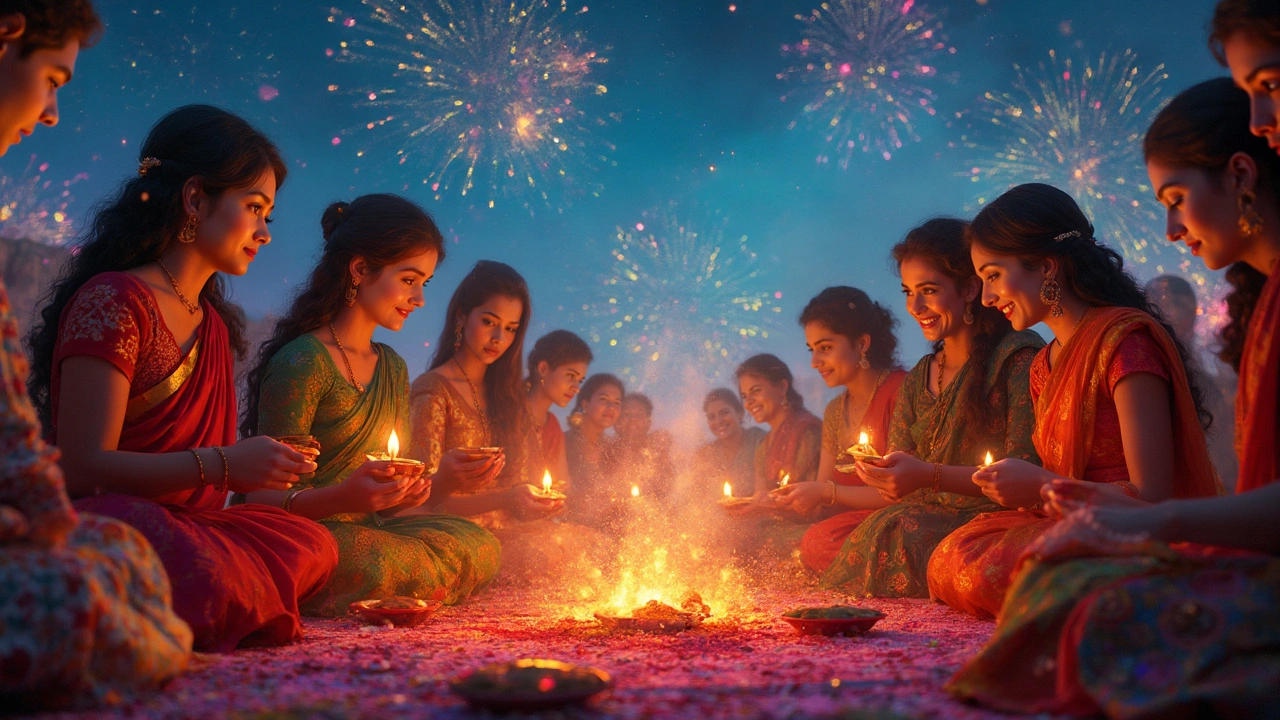The Heartbeat of a Nation: India's Motto Revealed
 Apr, 11 2025
Apr, 11 2025
India's motto isn't just a catchy phrase but a whole way of life—'Unity in Diversity.' Seriously, imagine getting along with over a billion people speaking different languages and practicing numerous religions! It’s wild, yet India makes it work, showing the world how diverse cultures can blend beautifully.
This concept didn't just pop up overnight, though. It's the result of a long, winding history where various influences and ideas fused together over centuries. You’ll find bits of this ethos sprinkled all over—from the bustling streets filled with vibrant sari colors to the soothing chants echoing from temples, mosques, and churches.
What’s even cooler? This motto is like a gentle guide for daily life. It steers everything from the education system to political debates. It's why festivals are extra vibrant here and how despite differences, harmony exists (most of the time!). Stick around to see how this motto isn't just an Indian tale but a cool lesson for anyone anywhere looking to find peace in diversity.
- Understanding the Indian Motto
- Historical Roots and Evolution
- Cultural Reflections of Unity
- Practical Ways the Motto Influences Daily Life
- Global Impact and Lessons from India
Understanding the Indian Motto
India’s motto, ‘Unity in Diversity’, might sound like a simple line, but it packs a lot of meaning. Think about it—this idea brings together people from over 28 states, speaking 22 official languages, and practicing multiple religions. It’s all about celebrating differences while finding common ground.
The motto isn’t just a recent phenomenon. It has roots in India's ancient times when traders, scholars, and conquerors from different parts of the world mingled here. This historical mingling of cultures made diversity a part of the national identity.
At its core, the motto encapsulates how various communities maintained their individual identities while being an integral part of a larger unit. It's like having a massive quilt where each patch is different, but they all stitch together to make something beautiful and unified.
In day-to-day life, this motto is visible everywhere, from multicultural festivals and celebrations to the diverse dishes that vary from state to state. For the folks living there, diversity isn’t something to be tolerated—it’s what makes life interesting!
Given India’s population of over 1.4 billion, maintaining unity is no small task. It’s a daily exercise of resilience and open-mindedness. This kind of cohesiveness speaks volumes on how differences can coexist peacefully, teaching the world that harmony in diversity is possible.
Such an approach proves invaluable and relevant, offering guidance to multi-ethnic societies across the globe. It serves as a reminder that embracing one’s roots while respecting others can forge stronger, more unified communities.
Historical Roots and Evolution
The phrase 'Unity in Diversity' isn't just a modern-day mantra but has deep historical foundations that go way back. Picture this: ancient Indian empires like the Maurya and Gupta dynasties, which were sprawling cultures accommodating different peoples and beliefs, laying the groundwork for what would become known as India today. They embraced this diversity and found strength in it, making it a cornerstone of governance and societal interaction.
Fast forward to the Mughal era, and you'll see how this idea really took off. The Mughals in India ruled over a vast and diverse population, leading to policies that emphasized inclusion. Leaders like Emperor Akbar were famous for their religious tolerance, setting up systems where people of different faiths worked together towards common goals. This opened up dialogues that enhanced the rich cultural tapestry of the land.
When the British arrived, they found a land already thriving on its multifaceted ethos. Despite attempts to divide and rule, the longstanding communal sense of unity among Indians became a powerful tool in the freedom struggle. This was evident in movements like the Non-Cooperation Movement led by Gandhi, where diverse communities came together for the shared goal of independence.
Finally, when India emerged as a free nation in 1947, its leaders embedded 'Unity in Diversity' into the Constitution. This was not just a nod to the past but a call to the future, urging citizens to uphold these values in shaping the nation.
The evolution of this motto is remarkable not just for its past but for how it continues to thrive today, reaffirming that diversity doesn't weaken but strengthens the social fabric of the nation. And guess what? This ethos doesn't just tie historic threads but offers inspiration for anyone seeking harmony in a multi-faceted world.

Cultural Reflections of Unity
In India, the motto of 'Unity in Diversity' isn't just words—it’s literally a way of life! You see it in how Indians celebrate their festivals. Imagine Diwali, Eid, and Christmas, all shining brightly across the same neighborhood. Each festival carries its traditions, yet people of different backgrounds join in the fun and joy. Why wouldn’t they? After all, it’s all about sharing lights, sweets, and smiles.
Take language, for instance. India boasts a massive linguistic diversity with 22 recognized languages (and hundreds more dialects), but there's a seamless blend of tongues in Bollywood films and music that everyone enjoys. Who hasn’t caught themselves humming a Hindi song even if they're not fluent?
Then there's food—an everlasting love in India! Regional cuisines feature unique flavors and techniques, but they often cross borders within the country. Dosas in Delhi, biryani in Bangalore, it’s a feast of flavors from every corner!
| Region | Main Cuisines |
|---|---|
| North India | Butter Chicken, Paneer Tikka |
| South India | Idli-Sambar, Dosa |
| East India | Macher Jhol, Momos |
| West India | Pav Bhaji, Vada Pav |
And let's not forget about arts and dance forms—imagine Kathak from the north blending with Bharatanatyam from the south at cultural festivals. Diverse yet unifying, they craft a stunning tapestry of creativity and harmony. These reflections of unity don’t just make India colorful but offer a lesson on embracing and thriving amidst differences.
Practical Ways the Motto Influences Daily Life
So, you might wonder, how does India keep its harmonious vibe amid all the diversity? Well, the 'Unity in Diversity' principle really does its magic daily. Let’s break down some of these everyday miracles.
First up is the education system. Schools across India emphasize inclusivity. Kids learn about various regional languages and cultures, ensuring respect from an early age. Celebrating different festivals right in the classroom helps foster this understanding. One moment they are making diyas for Diwali, and the next, they’re crafting paper hearts for Christmas.
"In diversity, there is beauty and there is strength." - Maya Angelou
Then there's the food scene. Indian families often serve meals with a mix of spices and ingredients from all over the country. If you’ve ever enjoyed a thali, you know it’s like having a world tour on your plate—celebrating the uniqueness of each state’s cuisine, yet it comes together perfectly.
Public services in India also reflect this motto. Despite the linguistic differences, you’ll find signs and announcements in multiple languages, making travel easier for everyone. It’s these small touches that keep the country knitted together.
Workplaces in India are another great example. Many companies actively encourage a mix of regional backgrounds in their teams. This not only boosts innovation but also builds stronger interpersonal ties. After all, teamwork is better when you understand and appreciate where each person is coming from.
Looking at everyday dress reveals more. Think of the vibrant mix during a typical Indian wedding, with guests in attire from different cultural backgrounds, all celebrating together. Clothing styles often merge influences, creating a tapestry of color and texture unique to India.
All these little everyday practices exemplify how India embodies the ‘Unity in Diversity’ ethos, setting a powerful model for the world. It goes beyond slogans and finds real meaning in how people live, learn, and celebrate their differences daily.

Global Impact and Lessons from India
India's motto of 'Unity in Diversity' is like a beacon shining out to the rest of the world. It's not just about singing kumbaya with a cup of chai; it's seriously influenced how countries view multicultural integration. And let's be honest, in today's interconnected world, that’s a big deal.
Take for instance India’s role in the United Nations. Being a founding member, India often champions this diversity vibe, urging other nations to embrace differences as a strength rather than a barrier. This approach has nudged international policies toward more inclusive frameworks.
But how does this translate into real-world impact? For starters, look at how India has become a software and tech powerhouse. Why? Because it’s a melting pot of ideas. Diverse minds bring unique perspectives, leading to innovation breakthroughs that tech hubs like Silicon Valley keep an eye on. This diversity holds real value, making workspaces more creative and competitive globally.
India also shows how to throw a party—well, more like thousands of them. Its cultural festivals like Diwali, Eid, and Christmas are celebrated with equal zest across various communities. Impressive, right? This encourages overseas Indians to spread their festive joy globally, easing cultural tensions and building bridges.
So, what can other countries learn from India? Here are some takeaways:
- Embrace all voices: Diversity can boost creativity and resilience in problem-solving.
- Celebrate differences: Festivities mixed with respect can bring communities closer.
- Unite for common goals: Even in a hugely diverse nation, common goals like growth can foster unity.
In 2020, a global study even found that 70% of companies with diversity policies had better results. Coincidence? We doubt it. India's journey reminds us that while we’re all different, we’re also the same in wanting to thrive together. Just like India does.